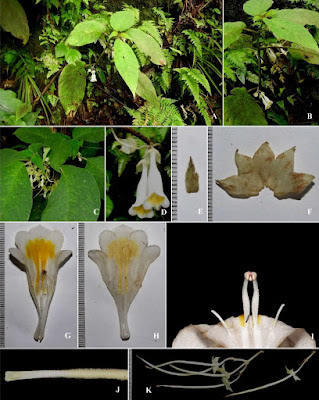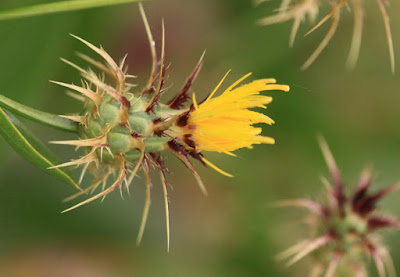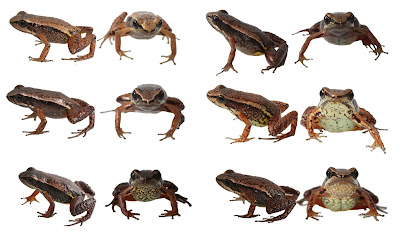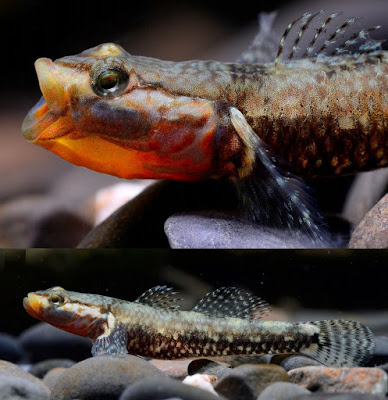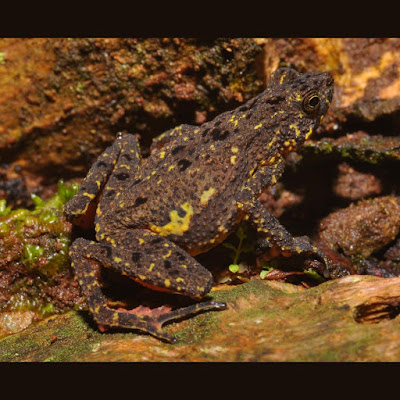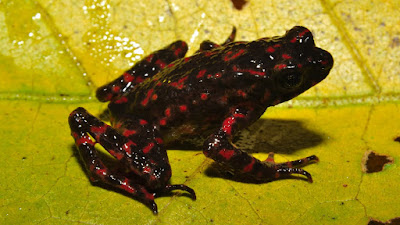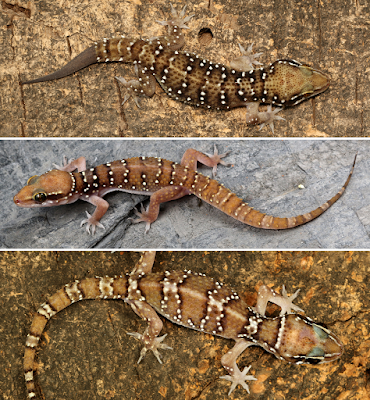[Most Recent Entries] [Calendar View]
Thursday, August 2nd, 2018
| Time | Event | ||||||||
| 8:29a | [Entomology • 2018] A New Status for Aclogryllus Gorochov, 2009 (Phalangopsidae; Phalangopsinae) with A New Species, Aclogryllus manauensis, from Brazilian Amazon
Abstract In this work, we propose to raise the subgenus Aclogryllus to generic status based on characteristics of external morphology and male genitalia. A new Amazonian species of Aclogryllus is also described. Photographs of nomenotypic species and the new Amazonian species are provided along with the description of morphological characteristics, diagnosis and photographs of male genitalia and female copulatory papilla. Key words: Crickets, Paragryllus, Paragryllina, Reserva Ducke, Amazon Forest, Brazil Order Orthoptera Oliver, 1789 Suborder Ensifera Chopard, 1921 Superfamily Grylloidea Laicharding, 1781 Family Gryllidae Laicharting, 1781 Subfamily Phalangopsinae Blanchard, 1845 Tribe Paragryllini Desutter, 1987 Subtribe Paragryllina Desutter, 1987 Aclogryllus Gorochov, 2009 n. stat. Type species: Aclogryllus crybelos (Nischk & Otte, 2000) n. comb. Aclogryllus crybelos (Nischk & Otte, 2000) n. comb.
Aclogryllus manauensis da Silva & Martins n. sp. Etymology. The specific name refers to type locality, the municipality of Manaus. Lúciene Gimaque da Silva, Luciano De Pinho Martins, Marcelo Ribeiro Pereira and Augusto Loureiro Henriques. 2018. A New Status for Aclogryllus Gorochov, 2009 (Phalangopsidae; Phalangopsinae; Paragryllini) with A New Species from Brazilian Amazon. Zootaxa. 4433(1); 101–110. DOI: 10.11646/zootaxa.4433.1.5 Resumo: Neste trabalho é proposto elevar o subgênero Aclogryllus para o status de gênero baseado em características da morfologia externa e genitália do macho. Também foi descrita uma nova espécie amazônica para Aclogryllus. Fotografias da espécie nominotípica e da nova espécie são apresentadas juntamente com a descrição das características morfológicas, diagnoses e fotografias da genitália masculina e da papila copulatória da fêmea. Palavras-chave: Grilos, Paragryllus, Paragryllina, Reserva Ducke, Floresta Amazônica, Brasil | ||||||||
| 9:16a | [Botany • 2018] Lysionotus bijantiae (Gesneriaceae) • A New Species of Lysionotus from Northeastern India
Abstract Lysionotus bijantiae, a new species of Lysionotus is described from Potin, Lower Subansiri District, Arunachal Pradesh, northeastern India. Detailed description, distribution along with color photographs are provided. A comparison chart of related species and a key to the taxa found in northeastern India are also provided. Keyword: Arunachal Pradesh, Gesneriaceae, India, Lysionotus bijantiae, New species Lysionotus bijantiae D. Borah & A. Joe, sp. nov. Lysionotus bijantiae is morphologically similar to L. gamosepalus but can be easily distinguished by a combination of characters such as erect sub-shrub (vs decumbent sub-shrub), stems pubescent (vs glabrous), leaves pubescent (vs glabrous), peduncles and petioles pubescent (vs glabrous), bracts lanceolate, villous (vs broadly ovate to orbicular, green, glabrous), calyx hairy, (vs glabrous), corolla cream (vs purplish), filaments curved (vs coiled), without connective appendage (vs horn-like connective appendage), pistil cream, pubescent (vs green, glabrous). Etymology: The species is named after Bijanti Borah, mother of first author for her constant support. Distribution and ecology: Lysionotus bijantiae is known only from the type locality. The plant was found growing in wet shady areas. According to the IUCN red list categories and criteria (IUCN, 2012), L. bijantiaeshould be assessed as Critically Endangered (CR) based on the present situation: restricted geographic range of less than 2 km2 with only one single location (CR:B2a) and an estimated number of mature individuals of about 100. Dipankar Borah and Alfred Joe. 2018. A New Species of Lysionotus (Gesneriaceae) from Northeastern India. Taiwania. 63(3); 232-234. DOI: 10.6165/tai.2018.63.232 | ||||||||
| 10:38a | [Botany • 2018] A Revision of Centaurea sect. Cynaroides (Asteraceae, Cardueae)
Abstract The taxonomic status of the taxa known to belong to Centaurea sect. Cynaroides and its close relatives was revised on the basis of herbarium specimens from the authors’ expeditions and other collections. It is established that Boissier is the correct author for C. sect. Cynaroides, and C. regia is designated as a lectotype of this section. Thirty seven species are recognised in the section. Three new species (Centaurea kamalnejadii, C. mozaffarianii, and C. zarrei), four new subspecies (C. amadanensis subsp. ranjbarii, C. cataonica subsp. syriaca, C. gigantea subsp. rechingeri, and C. kurdica subsp. ciliata) and two varieties (C. regia var. longispinosa and C. regia var. purpurea) are described. Two subspecies are reduced to the variety rank, and two varieties are elevated to the subspecies rank. Centaurea sect. Paraphysis is reduced as a synonym of C. sect. Cynaroides. Centaurea onopordifolia is transferred from C. sect. Cynaroides to a new section, i.e. C. sect. Cardueae. Three lectotypes are designated, six lectotypes from previous lectotypifications are rejected and the author names for six species are corrected. The recognized taxa, the relevant synonyms, type details, examined specimen lists, full descriptions and a taxonomic key are provided for this section. Distribution maps are provided for each sections, species, subspecies and varieties. Images of the type specimens of all taxa and also photos of the species in its natural habitat and related fields are provided. Five chromosome counts (2n = 18) are reported for C. amadanensis subsp. amadanensis, C. amadanensis subsp. gymnoclada, C. nemecii, C. regia var. regia, and C. regia var. purpurea. Biogeographical distribution and ecology of taxa of C. sect. Cynaroides are presented and discussed. In addition, cytotaxonomy, homoploidy and evolution of C. sect. Cynaroides are illustrated and discussed. Finally, the pollination of C. sect. Cynaroides is illustrated, and also images of the pollinators of some species of the section are provided. Keywords: Eudicots, chromosome numbers, Compositae, identification key, lectotypifications, new combinations, new section, nomenclature, taxonomy
Kazem Negaresh and Mohammad Reza Rahiminejad. 2018. A Revision of Centaurea sect. Cynaroides (Asteraceae, Cardueae—Centaureinae). Phytotaxa. 363(1); 1–131. DOI: 10.11646/phytotaxa.363.1.1 | ||||||||
| 2:11p | [Herpetology • 2018] Hyloxalus felixcoperari • A New Species of Hyloxalus (Anura: Dendrobatidae: Hyloxalinae) from A Cloud Forest near Bogotá, Colombia, with Comments on the subpunctatus clade
Abstract A new species of frog of the genus Hyloxalus from a high Andean forest of the central parts of the Cordillera Oriental, Colombia is recognized and described using integrative taxonomy. Using phylogenetic analyses of 2590 base pairs (bp) of mitochondrial DNA, Hyloxalus felixcoperari sp. nov. was shown to belong to a lineage of the subpunctatus clade, part of a subgroup that comprises high altitude-occurring lineages (subgroup I) and sister taxa of H. subpunctatus sensu stricto from the Bogotá plateau region. The genetic distance between both taxa is 2.1% and 5.1% for the 16S and cytochrome b gene fragments respectively. Hyloxalus felixcoperari sp. nov. is a medium-sized frog, which can be distinguished morphologically from H. subpunctatus by having dark throat and chest and unwebbed toes, and bioacoustically by emitting an advertisement call consisting of trill-like calls repeated at a rate of 50 –104 repititions/min, with a dominant frequency ranging from 3028.9–3861.2 Hz. Molecular dating analysis revealed that the already known lineages of the subpunctatus clade subgroup I from the middle Cordillera Oriental of Colombia, recently diverged during the lower Pleistocene – Upper Pliocene, most probably due to environmental fluctuations. Threats and main aspects of the natural history of this new species including breeding and habitat are reported in this article. Key words Bioacoustics, Cordillera Oriental, high Andean, lower Pleistocene, mitochondrial DNA, recent radiation, upper Pliocene. Hyloxalus felixcoperari sp. nov. Diagnosis A species of Hyloxalus characterized by (1) SVL of adult males between 20.3–20.8 mm (20.6±0.2, n=3), and adult females between 21.4– 23.8 mm (22.4±1.2, n=3); (2) disc on Finger III not expanded, the width of the adjacent phalange between 72.9 –96.4% of disc; (3) when adpressed, Finger I equal or slightly shorter than Finger II; (4) fringe absent on the fingers; (5) disc on Toe IV slightly expanded, the width of the adjacent phalange between 63.2–75.4% of disc; (6) fringe absent on Toe IV and on other toes; (7) outer tarsal fold absent and inner tarsal fold, present and elongated tubercle-like; (8) toes unwebbed; (9) dorsolateral stripe absent; (10) oblique lateral stripe present, extending from groin to eye; (11) ventrolateral stripe absent; (12) throat, chest, and anterior part of the abdomen sexually dimorphic: in adult males, throat and chest dark and in adult females, cream with irregular spots or dark brown reticulations; (13) abdomen cream with brown reticulations in females (Fig. 7), in adult males it turns light brown with diffuse cream spots; (14) Finger III not swollen in males; (15) testes white; (16) adult males without black, pale or dark grey arm gland; (17) cloacal tubercles absent; (18) incomplete pupil ring; (19) the call with dominant frequency between 3028.9–3861.2 Hz. Etymology. The specific epithet of this dendrobatid frog is dedicated to Felix Acosta-Gualtero (1935–2015), who dedicated his life to the consolidation of the solidarity economy (Cooperativism) in Colombia, based on principles of participation, reciprocity and cooperation. Distribution. Hyloxalus felixcoperari sp. nov.is currently known only from the type locality at Natural Private Reserve Paso de Nubes, between 2500– 2577 m above sea level. The locality corresponds to a cloud Andean forest fragment located on the western slope of the Cordillera Oriental of Colombia (Fig. 1). Andrés R. Acosta-Galvis and Mario Vargas-Ramírez. 2018. A New Species of Hyloxalus Jiménez De La Espada, 1871 ‘‘1870’’ (Anura: Dendrobatidae: Hyloxalinae) from A Cloud Forest near Bogotá, Colombia, with Comments on the subpunctatus clade. VERTEBRATE ZOOLOGY. 68(2); 123–14. | ||||||||
| 2:23p | [Ichthyology • 2018] Rhinogobius immaculatus • A New Species of Freshwater Goby (Teleostei: Gobiidae) from the Qiantang River, China
Abstract A new freshwater goby, Rhinogobius immaculatus sp. nov., is described here from the Qiantang River in China. It is distinguished from all congeners by the following combination of characters: second dorsal-fin rays I, 7–9; anal-fin rays I, 6–8; pectoral-fin rays 14–15; longitudinal scales 29–31; transverse scales 7–9; predorsal scales 2–5; vertebrae 27 (rarely 28); preopercular canal absent or with two pores; a red oblique stripe below eye in males; branchiostegal membrane mostly reddish-orange, with 3–6 irregular discrete or connected red blotches on posterior branchiostegal membrane and lower operculum in males; caudal-fin base with a median black spot; and no black blotch on anterior part of first dorsal fin in males. Keywords: Gobiidae, Rhinogobius, New species, Qiantang River, China
Rhinogobius immaculatus sp. nov. Diagnosis: Most similar to Rhinogobius wuyanlingensis in number of vertebrae (27) and preopercular canal pores (2 or 0 vs. 2), but differing by fewer pectoral-fin rays (14–15 vs. 17–18), fewer anal-fin rays (I, 6–7 vs. I, 8), fewer transverse scales (7–9, modally 8 vs. 9–10), absence of a black blotch on anterior part of first dorsal fin in males (vs. present), and branchiostegal membrane mostly reddish-orange, with irregular blotches posteriorly in males (vs. with red stripes). .... Distribution and ecology: Known only from streams of the Qiantang River basin in Zhejiang and Anhui Provinces, China (Figure 6). Most often found in shallow (10–50 cm deep) low-gradient streams, with sand and gravel mixed substrate. Adult Rhinogobius immaculatus sp. nov. are small in size. The smallest female with mature oocytes was 22.4 mm SL. The largest specimen collected in the field was 26.3 mm SL. The largest captive specimen kept in an aquarium for 29 months was 32.8 mm SL. Etymology: The specific name, immaculatus, is derived from Latin in (without) and maculatus (spotted), an adjective, alluding to the absence of a black blotch on the anterior part of the dorsal fin in adult males. Fan Li, Shan Li and Jia-Kuan Chen. 2018. Rhinogobius immaculatus, A New Species of Freshwater Goby (Teleostei: Gobiidae) from the Qiantang River, China. Zoological Research. 39(6); 396-405. DOI: 10.24272/j.issn.2095-8137.2018.065 | ||||||||
| 2:40p | [Herpetology • 2018] Leptophryne javanica • Detection of Cryptic Taxa in the Genus Leptophryne (Fitzinger, 1843) (Amphibia; Bufonidae) and The Description of A New Species from Java, Indonesia
Abstract We investigated phylogenetic relationships among populations of two species within the genus Leptophryne, L. cruentata and L. borbonica, using the mitochondrial 16S rRNA gene. As a result, we identified two distinct lineages within populations currently considered Leptophryne cruentata: 1) a lineage containing L. cruentata from the type locality, and 2) a lineage from Mt. Slamet and Mt. Ciremai. On the basis of genetic and morphological differences, we describe the Mt. Slamet and Mt. Ciremai populations as a new species, Leptophryne javanica sp. nov. The new species is distinguished from L. cruentata and L. borbonica by the following combination of morphological characters: the presence of distinct yellow mottling on the dorsum; relatively small body size (SVL male 22.2–24.0 mm, female 29.6 mm); relatively short hindlimbs (HLL 37.0–40.9 mm); relatively short fourth toe (4ToeL 4.3–6.0 mm); basal webbing on the hands, but well developed on toes; very protruding snout and an indistinct tympanum. In our preliminary phylogenetic analysis, we also detected four distinct lineages within Leptophryne borbonica: 1) a lineage containing true L. borbonica from west Java, 2) a lineage from Lampung (Sumatra I), 3) a lineage from northern Borneo, and 4) a lineage from Bengkulu (Sumatra II). Further studies are needed to determine taxonomic status of these lineages. Keywords: Amphibia, Leptophryne javanica, new species, Sundaland, taxonomy
Leptophryne javanica new species Leptophryne cruentata (Tschudi, 1838): Mumpuni 2014 Etymology. The specific epithet is in reference to Java, the island where the type series was collected. Range. Leptophryne javanica sp. nov. is currently known only from the northwestern slope of Mt. Slamet and Mt. Ciremai (Fig. 1). Since L. cruentata is endemic to mountains in the west of Java, Leptophryne javanica sp. nov. is likely endemic to mountains in the central part of the island .... 
Amir Hamidy, Misbahul Munir, Mumpuni Mumpuni, Mila Rahmania and Azis Abdul Kholik. 2018. Detection of Cryptic Taxa in the Genus Leptophryne (Fitzinger, 1843) (Amphibia; Bufonidae) and The Description of A New Species from Java, Indonesia. Zootaxa. 4450(4); 427–444. DOI: 10.11646/zootaxa.4450.4.2 Spesies Kodok Baru Ditemukan, Ada di Gunung Slamet dan Gunung Ciremai kumparan.com/@kumparansains/spesies-kodo Spesies Baru “Kodok Merah Ciremai” #kodokMerahCiremai #LeptophryneJavanica #ayoketamannasional #gunungciremai #wonderfulindonesia #pesonaindonesia   | ||||||||
| 3:17p | [Herpetology • 2018] First Appearance Deceives Many: Disentangling the Hemidactylus triedrus species complex Using An Integrated Approach; Hemidactylus whitakeri & H. sahgali
Abstract The gekkonid lizard genus Hemidactylus Oken is the second most species-rich genus of geckos with greatest diversity in the tropical regions of the world. Some species of the genus are commensal and widespread; however, there are several endemic lineages with restricted distribution. India is home to at least 35 species, with 20 endemic species and the number is steadily increasing with exploration of new habitats and integrated taxonomic approach including molecular data. We made investigations into the molecular and morphological variation throughout the distribution of Hemidactylus triedrus Daudin, 1802 based on fresh specimens, literature review, museum material and molecular data. Results from morphological, molecular and micro-CT based anatomical data are unequivocal and show that H. triedrus is a species complex represented by three species, H. triedrus sensu stricto and two undescribed taxa. H. subtriedrus Jerdon, 1854 syn. nov. was found to be morphologically similar to the type specimen of H. triedrus, and genetically embedded in a clade containing H. triedrus sensu stricto and is here treated as a junior synonym of H. triedrus, whereas H. lankae Deraniyagala is referred to as nomen dubium given that the types are presently not traceable and the original description is inadequate in diagnosing the taxon. The populations from western-central India and parts of Pakistan, and from southern Karnataka are distinct and diagnosable, and are herein described as two new species, respectively. Morphological and molecular data support the distinctiveness of the new species. The present work resolves a taxonomic turmoil that lasted over two centuries highlighting the need for studies that integrate morphological and molecular data. .... Hemidactylus triedrus species group Species included: H. triedrus, H. sahgali sp. nov., H. whitakeri sp. nov. Definition: Members of the group grow to a medium size ranging from 45–74 mm in SVL with a rather robust habitus. Dorsum with distinct dark bands may be edged with white or lighter shade of brown. Scales on the dorsal aspect of trunk granular intermixed with large keeled sub-trihedral or trihedral tubercles arranged in 15–20 fairly regular rows. Supralabial eight to nine and infralabials seven to eight to angle of jaw. Lamellae on digit one of manus and pes range from seven to eight and on digit four of manus and pes range from 8–10. Males possess a series of 7–15 precloacal femoral pores interrupted medially by a diastema of one to three non-pored scales. A single or a pair of sub-conical to rounded post cloacal spur. Tail with usually eight keeled tubercles in a whorl on segment I, the number subsequently reduces with progression of tail segments. Distribution: Widespread across dry zones of India and Sri Lanka and parts of Pakistan.
Hemidactylus triedrus Daudin, 1802 Gecko triedrus Daudin, 1802:155 Hemidactylus triedrus Lesson, 1834:311; Boulenger, 1885:133 (in part); Smith, 1935:88 (in part) Hemidactylus subtriedrus Jerdon, 1854:467; Smith, 1935:89 syn. nov. Hemidactylus triedrus lankae Somaweera & Somaweera, 2009:180 Hemidactylus lankae Bauer et al., 2010:350 Diagnosis: A medium sized fairly stout gecko, adults ranging 58–76 mm in SVL. Dorsum in a shade of light brown with paired, thin black edged white bands at regular intervals. Dorsal scalation on trunk, granular, intermixed with enlarged, keeled 19–20 trihedral tubercle rows arranged in fairly regular longitudinal series. Seven lamellae under digit I of pes and manus, eight to nine under digit four of manus and pes. An angular series of seven to nine precloacal femoral pores separated at mid-pelvic by a diastema of one to three non-pored scales. Suggested common name: Southern termite hill gecko. Natural history: A species generally associated with termite mounds. Several individuals of different age classes can be seen occupying a single mound. Individuals can be seen at the entrance of the openings of termite mounds just after dusk and will retreat in the mound with the slightest disturbance. Juveniles when disturbed will attain a posture with their bodies high and the tail is moved slowly in a curling and uncurling manner, likely to draw attention toward the tail. Several individuals were found in a single mound when the termite mound was dug, along with scorpions of the genus Heterometrus sp., and frogs of the genus Uperodon sp. Individuals also seek shelter under boulders, abandoned houses during the day emerging just after dusk. Mostly terrestrial in its habits but will climb trees too. Breeding likely takes places from February to May as hatchlings and eggs have been seen in the months of April–May in Pondicherry and Kanyakumari. Occupies areas that are dry like scrub, dominated with boulders and even in cities closer to the coast. Widely distributed from Visakhapatnam in north to Kanyakumari in south and recorded from elevation ranging from 17 to 1,913 m AMSL. Recorded from the following states/Union territories in India: Kerala, Tamil Nadu, Andhra Pradesh and Pondicherry (Fig. 6).
Hemidactylus whitakeri sp. nov. Hemidactylus subtriedrus Bauer et al., 2010 Hemidactylus triedrus Bansal & Karanth, 2010 Diagnosis: A medium sized fairly stout gecko, adults ranging 45–60 mm in SVL. Dorsum in a shade of light brown with paired, thin black edged white bands at regular intervals. Dorsal scalation on trunk granular, intermixed with enlarged, keeled 16–17 sub-trihedral tubercle rows arranged in fairly regular longitudinal series on dorsum. Seven lamellae (rarely six) under digit I of pes and manus, eight to nine under digit four of manus and pes. An angular series of seven to eight precloacal femoral pores separated at a mid-pelvic by a diastema of three non-pored scales. Etymology: The specific epithet is a patronym honoring Romulus Earl Whitaker for his valuable contribution toward the study and conservation of reptiles of India. Suggested common name: Whitaker’s termite hill gecko. Natural history: The types were found moving actively at a quarry site around 20:30 h. The holotype female contains two eggs in her body cavity suggesting that this species breeds during the months of November. Several hatchlings of the new species were encountered at Kengiri near Bangalore in the month of April. Similar in its habits to H. triedrus and can be seen on termite mounds. Its distribution is not well known and known from Bangalore in the state of Karnataka and the Nilgiri district in Tamil Nadu (Fig. 6).
Hemidactylus sahgali sp. nov. Hemidactylus triedrus Boulenger, 1885:133 (in part); Smith, 1935:88 (in part); Minton, 1966:85; Bauer et al., 2010 Diagnosis: A medium sized fairly stout gecko, adults ranging 56–78 mm in SVL. Dorsum in a shade of light brown with paired, broad black edged white bands at regular intervals. Dorsal scalation on trunk, granular, intermixed with enlarged, keeled 15–16 trihedral tubercle rows arranged in fairly regular longitudinal series. Seven to eight lamellae under digit I of pes and manus, 8–10 under digit four of manus and pes. An angular series of 11–15 precloacal femoral pores separated at a mid-pelvic by a diastema of one to three non-pored scales. Etymology: The specific epithet is a patronym honoring Bittu Sahgal, Editor and founder of Sanctuary Asia magazine for his contribution toward conservation of wildlife. Suggested common name: Sahgal’s termite hill gecko. Natural history: A species associated with termite mounds as its related species H. triedrus. Found in dry open scrub areas with boulders. Seen actively moving about on the ground just after dusk. Hatchlings have been seen in the month of May. Distributed throughout the Deccan Traps, its distribution extends beyond the traps north-west into Pakistan. In India, it is recorded from the following states: Maharashtra, Gujarat, Madhya Pradesh, Rajasthan and Chhattisgarh records ranging in elevation from 11 to 1,191 m AMSL. All records of the species from Pakistan are from elevation ranging from 15 to 25 m AMSL. Zeeshan A. Mirza, Gaurang G. Gowande, Rishikesh Patil, Mayuresh Ambekar and Harshil Patel. 2018. First Appearance Deceives Many: Disentangling the Hemidactylus triedrus species complex Using An Integrated Approach. PeerJ. 6:e5341 DOI: 10.7717/peerj.5341 |
| << Previous Day |
2018/08/02 [Calendar] |
Next Day >> |



